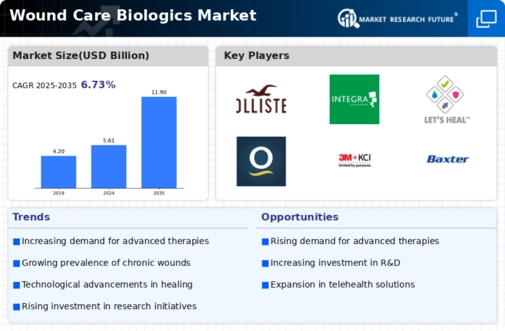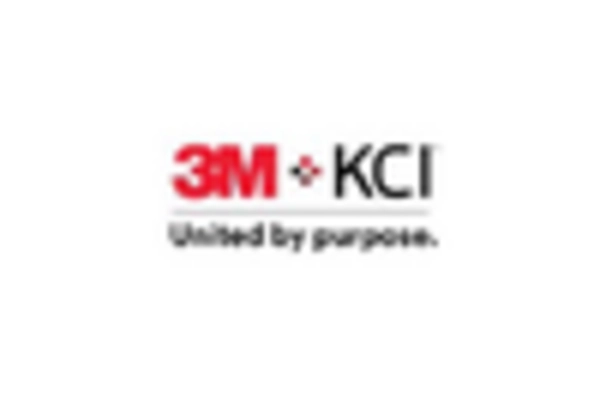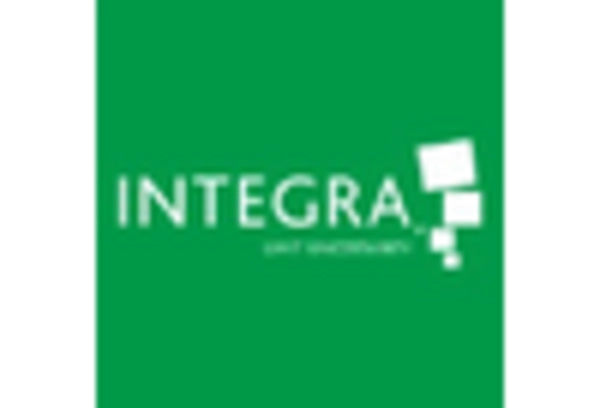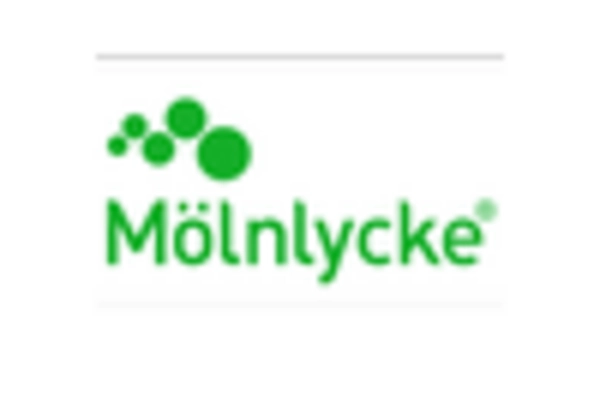-
EXECUTIVE SUMMARY
-
Market Overview
-
Key Findings
-
Market Segmentation
-
Competitive Landscape
-
Challenges and Opportunities
-
Future Outlook
-
MARKET INTRODUCTION
-
Definition
-
Scope of the study
- Research Objective
- Assumption
- Limitations
-
RESEARCH METHODOLOGY
-
Overview
-
Data Mining
-
Secondary Research
-
Primary Research
- Primary Interviews and Information Gathering Process
- Breakdown of Primary Respondents
-
Forecasting Model
-
Market Size Estimation
- Bottom-Up Approach
- Top-Down Approach
-
Data Triangulation
-
Validation
-
MARKET DYNAMICS
-
Overview
-
Drivers
-
Restraints
-
Opportunities
-
MARKET FACTOR ANALYSIS
-
Value chain Analysis
-
Porter''s Five Forces Analysis
- Bargaining Power of Suppliers
- Bargaining Power of Buyers
- Threat of New Entrants
- Threat of Substitutes
- Intensity of Rivalry
-
COVID-19 Impact Analysis
- Market Impact Analysis
- Regional Impact
- Opportunity and Threat Analysis
-
WOUND CARE BIOLOGICS MARKET, BY PRODUCT TYPE (USD BILLION)
-
Collagen-based Dressings
-
Skin Substitutes
-
Growth Factor-based Products
-
Hyaluronic Acid Dressings
-
WOUND CARE BIOLOGICS MARKET, BY WOUND TYPE (USD BILLION)
-
Acute Wounds
-
Chronic Wounds
-
Surgical Wounds
-
Traumatic Wounds
-
WOUND CARE BIOLOGICS MARKET, BY END USER (USD BILLION)
-
Hospitals
-
Home Healthcare
-
Long-term Care Facilities
-
Specialty Clinics
-
WOUND CARE BIOLOGICS MARKET, BY APPLICATION (USD BILLION)
-
Surgical Application
-
Burn Treatment
-
Diabetic Foot Ulcers
-
Venous Leg Ulcers
-
WOUND CARE BIOLOGICS MARKET, BY REGIONAL (USD BILLION)
-
North America
- US
- Canada
-
Europe
- Germany
- UK
- France
- Russia
- Italy
- Spain
- Rest of Europe
-
APAC
- China
- India
- Japan
- South Korea
- Malaysia
- Thailand
- Indonesia
- Rest of APAC
-
South America
- Brazil
- Mexico
- Argentina
- Rest of South America
-
MEA
- GCC Countries
- South Africa
- Rest of MEA
-
COMPETITIVE LANDSCAPE
-
Overview
-
Competitive Analysis
-
Market share Analysis
-
Major Growth Strategy in the Wound Care Biologics Market
-
Competitive Benchmarking
-
Leading Players in Terms of Number of Developments in the Wound Care Biologics Market
-
Key developments and growth strategies
- New Product Launch/Service Deployment
- Merger & Acquisitions
- Joint Ventures
-
Major Players Financial Matrix
- Sales and Operating Income
- Major Players R&D Expenditure. 2023
-
COMPANY PROFILES
-
Hollister
- Financial Overview
- Products Offered
- Key Developments
- SWOT Analysis
- Key Strategies
-
Integra LifeSciences
- Financial Overview
- Products Offered
- Key Developments
- SWOT Analysis
- Key Strategies
-
KCI Medical
- Financial Overview
- Products Offered
- Key Developments
- SWOT Analysis
- Key Strategies
-
Systagenix
- Financial Overview
- Products Offered
- Key Developments
- SWOT Analysis
- Key Strategies
-
Organogenesis
- Financial Overview
- Products Offered
- Key Developments
- SWOT Analysis
- Key Strategies
-
Derma Sciences
- Financial Overview
- Products Offered
- Key Developments
- SWOT Analysis
- Key Strategies
-
Acelity
- Financial Overview
- Products Offered
- Key Developments
- SWOT Analysis
- Key Strategies
-
Baxter International
- Financial Overview
- Products Offered
- Key Developments
- SWOT Analysis
- Key Strategies
-
Woundtech
- Financial Overview
- Products Offered
- Key Developments
- SWOT Analysis
- Key Strategies
-
Smith and Nephew
- Financial Overview
- Products Offered
- Key Developments
- SWOT Analysis
- Key Strategies
-
3M
- Financial Overview
- Products Offered
- Key Developments
- SWOT Analysis
- Key Strategies
-
ConvaTec
- Financial Overview
- Products Offered
- Key Developments
- SWOT Analysis
- Key Strategies
-
Medtronic
- Financial Overview
- Products Offered
- Key Developments
- SWOT Analysis
- Key Strategies
-
Collagen Solutions
- Financial Overview
- Products Offered
- Key Developments
- SWOT Analysis
- Key Strategies
-
APPENDIX
-
References
-
Related Reports
-
LIST OF TABLES
-
LIST OF ASSUMPTIONS
-
NORTH AMERICA WOUND CARE BIOLOGICS MARKET SIZE ESTIMATES & FORECAST, BY PRODUCT TYPE, 2019-2032 (USD BILLIONS)
-
NORTH AMERICA WOUND CARE BIOLOGICS MARKET SIZE ESTIMATES & FORECAST, BY WOUND TYPE, 2019-2032 (USD BILLIONS)
-
NORTH AMERICA WOUND CARE BIOLOGICS MARKET SIZE ESTIMATES & FORECAST, BY END USER, 2019-2032 (USD BILLIONS)
-
NORTH AMERICA WOUND CARE BIOLOGICS MARKET SIZE ESTIMATES & FORECAST, BY APPLICATION, 2019-2032 (USD BILLIONS)
-
NORTH AMERICA WOUND CARE BIOLOGICS MARKET SIZE ESTIMATES & FORECAST, BY REGIONAL, 2019-2032 (USD BILLIONS)
-
US WOUND CARE BIOLOGICS MARKET SIZE ESTIMATES & FORECAST, BY PRODUCT TYPE, 2019-2032 (USD BILLIONS)
-
US WOUND CARE BIOLOGICS MARKET SIZE ESTIMATES & FORECAST, BY WOUND TYPE, 2019-2032 (USD BILLIONS)
-
US WOUND CARE BIOLOGICS MARKET SIZE ESTIMATES & FORECAST, BY END USER, 2019-2032 (USD BILLIONS)
-
US WOUND CARE BIOLOGICS MARKET SIZE ESTIMATES & FORECAST, BY APPLICATION, 2019-2032 (USD BILLIONS)
-
US WOUND CARE BIOLOGICS MARKET SIZE ESTIMATES & FORECAST, BY REGIONAL, 2019-2032 (USD BILLIONS)
-
CANADA WOUND CARE BIOLOGICS MARKET SIZE ESTIMATES & FORECAST, BY PRODUCT TYPE, 2019-2032 (USD BILLIONS)
-
CANADA WOUND CARE BIOLOGICS MARKET SIZE ESTIMATES & FORECAST, BY WOUND TYPE, 2019-2032 (USD BILLIONS)
-
CANADA WOUND CARE BIOLOGICS MARKET SIZE ESTIMATES & FORECAST, BY END USER, 2019-2032 (USD BILLIONS)
-
CANADA WOUND CARE BIOLOGICS MARKET SIZE ESTIMATES & FORECAST, BY APPLICATION, 2019-2032 (USD BILLIONS)
-
CANADA WOUND CARE BIOLOGICS MARKET SIZE ESTIMATES & FORECAST, BY REGIONAL, 2019-2032 (USD BILLIONS)
-
EUROPE WOUND CARE BIOLOGICS MARKET SIZE ESTIMATES & FORECAST, BY PRODUCT TYPE, 2019-2032 (USD BILLIONS)
-
EUROPE WOUND CARE BIOLOGICS MARKET SIZE ESTIMATES & FORECAST, BY WOUND TYPE, 2019-2032 (USD BILLIONS)
-
EUROPE WOUND CARE BIOLOGICS MARKET SIZE ESTIMATES & FORECAST, BY END USER, 2019-2032 (USD BILLIONS)
-
EUROPE WOUND CARE BIOLOGICS MARKET SIZE ESTIMATES & FORECAST, BY APPLICATION, 2019-2032 (USD BILLIONS)
-
EUROPE WOUND CARE BIOLOGICS MARKET SIZE ESTIMATES & FORECAST, BY REGIONAL, 2019-2032 (USD BILLIONS)
-
GERMANY WOUND CARE BIOLOGICS MARKET SIZE ESTIMATES & FORECAST, BY PRODUCT TYPE, 2019-2032 (USD BILLIONS)
-
GERMANY WOUND CARE BIOLOGICS MARKET SIZE ESTIMATES & FORECAST, BY WOUND TYPE, 2019-2032 (USD BILLIONS)
-
GERMANY WOUND CARE BIOLOGICS MARKET SIZE ESTIMATES & FORECAST, BY END USER, 2019-2032 (USD BILLIONS)
-
GERMANY WOUND CARE BIOLOGICS MARKET SIZE ESTIMATES & FORECAST, BY APPLICATION, 2019-2032 (USD BILLIONS)
-
GERMANY WOUND CARE BIOLOGICS MARKET SIZE ESTIMATES & FORECAST, BY REGIONAL, 2019-2032 (USD BILLIONS)
-
UK WOUND CARE BIOLOGICS MARKET SIZE ESTIMATES & FORECAST, BY PRODUCT TYPE, 2019-2032 (USD BILLIONS)
-
UK WOUND CARE BIOLOGICS MARKET SIZE ESTIMATES & FORECAST, BY WOUND TYPE, 2019-2032 (USD BILLIONS)
-
UK WOUND CARE BIOLOGICS MARKET SIZE ESTIMATES & FORECAST, BY END USER, 2019-2032 (USD BILLIONS)
-
UK WOUND CARE BIOLOGICS MARKET SIZE ESTIMATES & FORECAST, BY APPLICATION, 2019-2032 (USD BILLIONS)
-
UK WOUND CARE BIOLOGICS MARKET SIZE ESTIMATES & FORECAST, BY REGIONAL, 2019-2032 (USD BILLIONS)
-
FRANCE WOUND CARE BIOLOGICS MARKET SIZE ESTIMATES & FORECAST, BY PRODUCT TYPE, 2019-2032 (USD BILLIONS)
-
FRANCE WOUND CARE BIOLOGICS MARKET SIZE ESTIMATES & FORECAST, BY WOUND TYPE, 2019-2032 (USD BILLIONS)
-
FRANCE WOUND CARE BIOLOGICS MARKET SIZE ESTIMATES & FORECAST, BY END USER, 2019-2032 (USD BILLIONS)
-
FRANCE WOUND CARE BIOLOGICS MARKET SIZE ESTIMATES & FORECAST, BY APPLICATION, 2019-2032 (USD BILLIONS)
-
FRANCE WOUND CARE BIOLOGICS MARKET SIZE ESTIMATES & FORECAST, BY REGIONAL, 2019-2032 (USD BILLIONS)
-
RUSSIA WOUND CARE BIOLOGICS MARKET SIZE ESTIMATES & FORECAST, BY PRODUCT TYPE, 2019-2032 (USD BILLIONS)
-
RUSSIA WOUND CARE BIOLOGICS MARKET SIZE ESTIMATES & FORECAST, BY WOUND TYPE, 2019-2032 (USD BILLIONS)
-
RUSSIA WOUND CARE BIOLOGICS MARKET SIZE ESTIMATES & FORECAST, BY END USER, 2019-2032 (USD BILLIONS)
-
RUSSIA WOUND CARE BIOLOGICS MARKET SIZE ESTIMATES & FORECAST, BY APPLICATION, 2019-2032 (USD BILLIONS)
-
RUSSIA WOUND CARE BIOLOGICS MARKET SIZE ESTIMATES & FORECAST, BY REGIONAL, 2019-2032 (USD BILLIONS)
-
ITALY WOUND CARE BIOLOGICS MARKET SIZE ESTIMATES & FORECAST, BY PRODUCT TYPE, 2019-2032 (USD BILLIONS)
-
ITALY WOUND CARE BIOLOGICS MARKET SIZE ESTIMATES & FORECAST, BY WOUND TYPE, 2019-2032 (USD BILLIONS)
-
ITALY WOUND CARE BIOLOGICS MARKET SIZE ESTIMATES & FORECAST, BY END USER, 2019-2032 (USD BILLIONS)
-
ITALY WOUND CARE BIOLOGICS MARKET SIZE ESTIMATES & FORECAST, BY APPLICATION, 2019-2032 (USD BILLIONS)
-
ITALY WOUND CARE BIOLOGICS MARKET SIZE ESTIMATES & FORECAST, BY REGIONAL, 2019-2032 (USD BILLIONS)
-
SPAIN WOUND CARE BIOLOGICS MARKET SIZE ESTIMATES & FORECAST, BY PRODUCT TYPE, 2019-2032 (USD BILLIONS)
-
SPAIN WOUND CARE BIOLOGICS MARKET SIZE ESTIMATES & FORECAST, BY WOUND TYPE, 2019-2032 (USD BILLIONS)
-
SPAIN WOUND CARE BIOLOGICS MARKET SIZE ESTIMATES & FORECAST, BY END USER, 2019-2032 (USD BILLIONS)
-
SPAIN WOUND CARE BIOLOGICS MARKET SIZE ESTIMATES & FORECAST, BY APPLICATION, 2019-2032 (USD BILLIONS)
-
SPAIN WOUND CARE BIOLOGICS MARKET SIZE ESTIMATES & FORECAST, BY REGIONAL, 2019-2032 (USD BILLIONS)
-
REST OF EUROPE WOUND CARE BIOLOGICS MARKET SIZE ESTIMATES & FORECAST, BY PRODUCT TYPE, 2019-2032 (USD BILLIONS)
-
REST OF EUROPE WOUND CARE BIOLOGICS MARKET SIZE ESTIMATES & FORECAST, BY WOUND TYPE, 2019-2032 (USD BILLIONS)
-
REST OF EUROPE WOUND CARE BIOLOGICS MARKET SIZE ESTIMATES & FORECAST, BY END USER, 2019-2032 (USD BILLIONS)
-
REST OF EUROPE WOUND CARE BIOLOGICS MARKET SIZE ESTIMATES & FORECAST, BY APPLICATION, 2019-2032 (USD BILLIONS)
-
REST OF EUROPE WOUND CARE BIOLOGICS MARKET SIZE ESTIMATES & FORECAST, BY REGIONAL, 2019-2032 (USD BILLIONS)
-
APAC WOUND CARE BIOLOGICS MARKET SIZE ESTIMATES & FORECAST, BY PRODUCT TYPE, 2019-2032 (USD BILLIONS)
-
APAC WOUND CARE BIOLOGICS MARKET SIZE ESTIMATES & FORECAST, BY WOUND TYPE, 2019-2032 (USD BILLIONS)
-
APAC WOUND CARE BIOLOGICS MARKET SIZE ESTIMATES & FORECAST, BY END USER, 2019-2032 (USD BILLIONS)
-
APAC WOUND CARE BIOLOGICS MARKET SIZE ESTIMATES & FORECAST, BY APPLICATION, 2019-2032 (USD BILLIONS)
-
APAC WOUND CARE BIOLOGICS MARKET SIZE ESTIMATES & FORECAST, BY REGIONAL, 2019-2032 (USD BILLIONS)
-
CHINA WOUND CARE BIOLOGICS MARKET SIZE ESTIMATES & FORECAST, BY PRODUCT TYPE, 2019-2032 (USD BILLIONS)
-
CHINA WOUND CARE BIOLOGICS MARKET SIZE ESTIMATES & FORECAST, BY WOUND TYPE, 2019-2032 (USD BILLIONS)
-
CHINA WOUND CARE BIOLOGICS MARKET SIZE ESTIMATES & FORECAST, BY END USER, 2019-2032 (USD BILLIONS)
-
CHINA WOUND CARE BIOLOGICS MARKET SIZE ESTIMATES & FORECAST, BY APPLICATION, 2019-2032 (USD BILLIONS)
-
CHINA WOUND CARE BIOLOGICS MARKET SIZE ESTIMATES & FORECAST, BY REGIONAL, 2019-2032 (USD BILLIONS)
-
INDIA WOUND CARE BIOLOGICS MARKET SIZE ESTIMATES & FORECAST, BY PRODUCT TYPE, 2019-2032 (USD BILLIONS)
-
INDIA WOUND CARE BIOLOGICS MARKET SIZE ESTIMATES & FORECAST, BY WOUND TYPE, 2019-2032 (USD BILLIONS)
-
INDIA WOUND CARE BIOLOGICS MARKET SIZE ESTIMATES & FORECAST, BY END USER, 2019-2032 (USD BILLIONS)
-
INDIA WOUND CARE BIOLOGICS MARKET SIZE ESTIMATES & FORECAST, BY APPLICATION, 2019-2032 (USD BILLIONS)
-
INDIA WOUND CARE BIOLOGICS MARKET SIZE ESTIMATES & FORECAST, BY REGIONAL, 2019-2032 (USD BILLIONS)
-
JAPAN WOUND CARE BIOLOGICS MARKET SIZE ESTIMATES & FORECAST, BY PRODUCT TYPE, 2019-2032 (USD BILLIONS)
-
JAPAN WOUND CARE BIOLOGICS MARKET SIZE ESTIMATES & FORECAST, BY WOUND TYPE, 2019-2032 (USD BILLIONS)
-
JAPAN WOUND CARE BIOLOGICS MARKET SIZE ESTIMATES & FORECAST, BY END USER, 2019-2032 (USD BILLIONS)
-
JAPAN WOUND CARE BIOLOGICS MARKET SIZE ESTIMATES & FORECAST, BY APPLICATION, 2019-2032 (USD BILLIONS)
-
JAPAN WOUND CARE BIOLOGICS MARKET SIZE ESTIMATES & FORECAST, BY REGIONAL, 2019-2032 (USD BILLIONS)
-
SOUTH KOREA WOUND CARE BIOLOGICS MARKET SIZE ESTIMATES & FORECAST, BY PRODUCT TYPE, 2019-2032 (USD BILLIONS)
-
SOUTH KOREA WOUND CARE BIOLOGICS MARKET SIZE ESTIMATES & FORECAST, BY WOUND TYPE, 2019-2032 (USD BILLIONS)
-
SOUTH KOREA WOUND CARE BIOLOGICS MARKET SIZE ESTIMATES & FORECAST, BY END USER, 2019-2032 (USD BILLIONS)
-
SOUTH KOREA WOUND CARE BIOLOGICS MARKET SIZE ESTIMATES & FORECAST, BY APPLICATION, 2019-2032 (USD BILLIONS)
-
SOUTH KOREA WOUND CARE BIOLOGICS MARKET SIZE ESTIMATES & FORECAST, BY REGIONAL, 2019-2032 (USD BILLIONS)
-
MALAYSIA WOUND CARE BIOLOGICS MARKET SIZE ESTIMATES & FORECAST, BY PRODUCT TYPE, 2019-2032 (USD BILLIONS)
-
MALAYSIA WOUND CARE BIOLOGICS MARKET SIZE ESTIMATES & FORECAST, BY WOUND TYPE, 2019-2032 (USD BILLIONS)
-
MALAYSIA WOUND CARE BIOLOGICS MARKET SIZE ESTIMATES & FORECAST, BY END USER, 2019-2032 (USD BILLIONS)
-
MALAYSIA WOUND CARE BIOLOGICS MARKET SIZE ESTIMATES & FORECAST, BY APPLICATION, 2019-2032 (USD BILLIONS)
-
MALAYSIA WOUND CARE BIOLOGICS MARKET SIZE ESTIMATES & FORECAST, BY REGIONAL, 2019-2032 (USD BILLIONS)
-
THAILAND WOUND CARE BIOLOGICS MARKET SIZE ESTIMATES & FORECAST, BY PRODUCT TYPE, 2019-2032 (USD BILLIONS)
-
THAILAND WOUND CARE BIOLOGICS MARKET SIZE ESTIMATES & FORECAST, BY WOUND TYPE, 2019-2032 (USD BILLIONS)
-
THAILAND WOUND CARE BIOLOGICS MARKET SIZE ESTIMATES & FORECAST, BY END USER, 2019-2032 (USD BILLIONS)
-
THAILAND WOUND CARE BIOLOGICS MARKET SIZE ESTIMATES & FORECAST, BY APPLICATION, 2019-2032 (USD BILLIONS)
-
THAILAND WOUND CARE BIOLOGICS MARKET SIZE ESTIMATES & FORECAST, BY REGIONAL, 2019-2032 (USD BILLIONS)
-
INDONESIA WOUND CARE BIOLOGICS MARKET SIZE ESTIMATES & FORECAST, BY PRODUCT TYPE, 2019-2032 (USD BILLIONS)
-
INDONESIA WOUND CARE BIOLOGICS MARKET SIZE ESTIMATES & FORECAST, BY WOUND TYPE, 2019-2032 (USD BILLIONS)
-
INDONESIA WOUND CARE BIOLOGICS MARKET SIZE ESTIMATES & FORECAST, BY END USER, 2019-2032 (USD BILLIONS)
-
INDONESIA WOUND CARE BIOLOGICS MARKET SIZE ESTIMATES & FORECAST, BY APPLICATION, 2019-2032 (USD BILLIONS)
-
INDONESIA WOUND CARE BIOLOGICS MARKET SIZE ESTIMATES & FORECAST, BY REGIONAL, 2019-2032 (USD BILLIONS)
-
REST OF APAC WOUND CARE BIOLOGICS MARKET SIZE ESTIMATES & FORECAST, BY PRODUCT TYPE, 2019-2032 (USD BILLIONS)
-
REST OF APAC WOUND CARE BIOLOGICS MARKET SIZE ESTIMATES & FORECAST, BY WOUND TYPE, 2019-2032 (USD BILLIONS)
-
REST OF APAC WOUND CARE BIOLOGICS MARKET SIZE ESTIMATES & FORECAST, BY END USER, 2019-2032 (USD BILLIONS)
-
REST OF APAC WOUND CARE BIOLOGICS MARKET SIZE ESTIMATES & FORECAST, BY APPLICATION, 2019-2032 (USD BILLIONS)
-
REST OF APAC WOUND CARE BIOLOGICS MARKET SIZE ESTIMATES & FORECAST, BY REGIONAL, 2019-2032 (USD BILLIONS)
-
SOUTH AMERICA WOUND CARE BIOLOGICS MARKET SIZE ESTIMATES & FORECAST, BY PRODUCT TYPE, 2019-2032 (USD BILLIONS)
-
SOUTH AMERICA WOUND CARE BIOLOGICS MARKET SIZE ESTIMATES & FORECAST, BY WOUND TYPE, 2019-2032 (USD BILLIONS)
-
SOUTH AMERICA WOUND CARE BIOLOGICS MARKET SIZE ESTIMATES & FORECAST, BY END USER, 2019-2032 (USD BILLIONS)
-
SOUTH AMERICA WOUND CARE BIOLOGICS MARKET SIZE ESTIMATES & FORECAST, BY APPLICATION, 2019-2032 (USD BILLIONS)
-
SOUTH AMERICA WOUND CARE BIOLOGICS MARKET SIZE ESTIMATES & FORECAST, BY REGIONAL, 2019-2032 (USD BILLIONS)
-
BRAZIL WOUND CARE BIOLOGICS MARKET SIZE ESTIMATES & FORECAST, BY PRODUCT TYPE, 2019-2032 (USD BILLIONS)
-
BRAZIL WOUND CARE BIOLOGICS MARKET SIZE ESTIMATES & FORECAST, BY WOUND TYPE, 2019-2032 (USD BILLIONS)
-
BRAZIL WOUND CARE BIOLOGICS MARKET SIZE ESTIMATES & FORECAST, BY END USER, 2019-2032 (USD BILLIONS)
-
BRAZIL WOUND CARE BIOLOGICS MARKET SIZE ESTIMATES & FORECAST, BY APPLICATION, 2019-2032 (USD BILLIONS)
-
BRAZIL WOUND CARE BIOLOGICS MARKET SIZE ESTIMATES & FORECAST, BY REGIONAL, 2019-2032 (USD BILLIONS)
-
MEXICO WOUND CARE BIOLOGICS MARKET SIZE ESTIMATES & FORECAST, BY PRODUCT TYPE, 2019-2032 (USD BILLIONS)
-
MEXICO WOUND CARE BIOLOGICS MARKET SIZE ESTIMATES & FORECAST, BY WOUND TYPE, 2019-2032 (USD BILLIONS)
-
MEXICO WOUND CARE BIOLOGICS MARKET SIZE ESTIMATES & FORECAST, BY END USER, 2019-2032 (USD BILLIONS)
-
MEXICO WOUND CARE BIOLOGICS MARKET SIZE ESTIMATES & FORECAST, BY APPLICATION, 2019-2032 (USD BILLIONS)
-
MEXICO WOUND CARE BIOLOGICS MARKET SIZE ESTIMATES & FORECAST, BY REGIONAL, 2019-2032 (USD BILLIONS)
-
ARGENTINA WOUND CARE BIOLOGICS MARKET SIZE ESTIMATES & FORECAST, BY PRODUCT TYPE, 2019-2032 (USD BILLIONS)
-
ARGENTINA WOUND CARE BIOLOGICS MARKET SIZE ESTIMATES & FORECAST, BY WOUND TYPE, 2019-2032 (USD BILLIONS)
-
ARGENTINA WOUND CARE BIOLOGICS MARKET SIZE ESTIMATES & FORECAST, BY END USER, 2019-2032 (USD BILLIONS)
-
ARGENTINA WOUND CARE BIOLOGICS MARKET SIZE ESTIMATES & FORECAST, BY APPLICATION, 2019-2032 (USD BILLIONS)
-
ARGENTINA WOUND CARE BIOLOGICS MARKET SIZE ESTIMATES & FORECAST, BY REGIONAL, 2019-2032 (USD BILLIONS)
-
REST OF SOUTH AMERICA WOUND CARE BIOLOGICS MARKET SIZE ESTIMATES & FORECAST, BY PRODUCT TYPE, 2019-2032 (USD BILLIONS)
-
REST OF SOUTH AMERICA WOUND CARE BIOLOGICS MARKET SIZE ESTIMATES & FORECAST, BY WOUND TYPE, 2019-2032 (USD BILLIONS)
-
REST OF SOUTH AMERICA WOUND CARE BIOLOGICS MARKET SIZE ESTIMATES & FORECAST, BY END USER, 2019-2032 (USD BILLIONS)
-
REST OF SOUTH AMERICA WOUND CARE BIOLOGICS MARKET SIZE ESTIMATES & FORECAST, BY APPLICATION, 2019-2032 (USD BILLIONS)
-
REST OF SOUTH AMERICA WOUND CARE BIOLOGICS MARKET SIZE ESTIMATES & FORECAST, BY REGIONAL, 2019-2032 (USD BILLIONS)
-
MEA WOUND CARE BIOLOGICS MARKET SIZE ESTIMATES & FORECAST, BY PRODUCT TYPE, 2019-2032 (USD BILLIONS)
-
MEA WOUND CARE BIOLOGICS MARKET SIZE ESTIMATES & FORECAST, BY WOUND TYPE, 2019-2032 (USD BILLIONS)
-
MEA WOUND CARE BIOLOGICS MARKET SIZE ESTIMATES & FORECAST, BY END USER, 2019-2032 (USD BILLIONS)
-
MEA WOUND CARE BIOLOGICS MARKET SIZE ESTIMATES & FORECAST, BY APPLICATION, 2019-2032 (USD BILLIONS)
-
MEA WOUND CARE BIOLOGICS MARKET SIZE ESTIMATES & FORECAST, BY REGIONAL, 2019-2032 (USD BILLIONS)
-
GCC COUNTRIES WOUND CARE BIOLOGICS MARKET SIZE ESTIMATES & FORECAST, BY PRODUCT TYPE, 2019-2032 (USD BILLIONS)
-
GCC COUNTRIES WOUND CARE BIOLOGICS MARKET SIZE ESTIMATES & FORECAST, BY WOUND TYPE, 2019-2032 (USD BILLIONS)
-
GCC COUNTRIES WOUND CARE BIOLOGICS MARKET SIZE ESTIMATES & FORECAST, BY END USER, 2019-2032 (USD BILLIONS)
-
GCC COUNTRIES WOUND CARE BIOLOGICS MARKET SIZE ESTIMATES & FORECAST, BY APPLICATION, 2019-2032 (USD BILLIONS)
-
GCC COUNTRIES WOUND CARE BIOLOGICS MARKET SIZE ESTIMATES & FORECAST, BY REGIONAL, 2019-2032 (USD BILLIONS)
-
SOUTH AFRICA WOUND CARE BIOLOGICS MARKET SIZE ESTIMATES & FORECAST, BY PRODUCT TYPE, 2019-2032 (USD BILLIONS)
-
SOUTH AFRICA WOUND CARE BIOLOGICS MARKET SIZE ESTIMATES & FORECAST, BY WOUND TYPE, 2019-2032 (USD BILLIONS)
-
SOUTH AFRICA WOUND CARE BIOLOGICS MARKET SIZE ESTIMATES & FORECAST, BY END USER, 2019-2032 (USD BILLIONS)
-
SOUTH AFRICA WOUND CARE BIOLOGICS MARKET SIZE ESTIMATES & FORECAST, BY APPLICATION, 2019-2032 (USD BILLIONS)
-
SOUTH AFRICA WOUND CARE BIOLOGICS MARKET SIZE ESTIMATES & FORECAST, BY REGIONAL, 2019-2032 (USD BILLIONS)
-
REST OF MEA WOUND CARE BIOLOGICS MARKET SIZE ESTIMATES & FORECAST, BY PRODUCT TYPE, 2019-2032 (USD BILLIONS)
-
REST OF MEA WOUND CARE BIOLOGICS MARKET SIZE ESTIMATES & FORECAST, BY WOUND TYPE, 2019-2032 (USD BILLIONS)
-
REST OF MEA WOUND CARE BIOLOGICS MARKET SIZE ESTIMATES & FORECAST, BY END USER, 2019-2032 (USD BILLIONS)
-
REST OF MEA WOUND CARE BIOLOGICS MARKET SIZE ESTIMATES & FORECAST, BY APPLICATION, 2019-2032 (USD BILLIONS)
-
REST OF MEA WOUND CARE BIOLOGICS MARKET SIZE ESTIMATES & FORECAST, BY REGIONAL, 2019-2032 (USD BILLIONS)
-
PRODUCT LAUNCH/PRODUCT DEVELOPMENT/APPROVAL
-
ACQUISITION/PARTNERSHIP
-
LIST OF FIGURES
-
MARKET SYNOPSIS
-
NORTH AMERICA WOUND CARE BIOLOGICS MARKET ANALYSIS
-
US WOUND CARE BIOLOGICS MARKET ANALYSIS BY PRODUCT TYPE
-
US WOUND CARE BIOLOGICS MARKET ANALYSIS BY WOUND TYPE
-
US WOUND CARE BIOLOGICS MARKET ANALYSIS BY END USER
-
US WOUND CARE BIOLOGICS MARKET ANALYSIS BY APPLICATION
-
US WOUND CARE BIOLOGICS MARKET ANALYSIS BY REGIONAL
-
CANADA WOUND CARE BIOLOGICS MARKET ANALYSIS BY PRODUCT TYPE
-
CANADA WOUND CARE BIOLOGICS MARKET ANALYSIS BY WOUND TYPE
-
CANADA WOUND CARE BIOLOGICS MARKET ANALYSIS BY END USER
-
CANADA WOUND CARE BIOLOGICS MARKET ANALYSIS BY APPLICATION
-
CANADA WOUND CARE BIOLOGICS MARKET ANALYSIS BY REGIONAL
-
EUROPE WOUND CARE BIOLOGICS MARKET ANALYSIS
-
GERMANY WOUND CARE BIOLOGICS MARKET ANALYSIS BY PRODUCT TYPE
-
GERMANY WOUND CARE BIOLOGICS MARKET ANALYSIS BY WOUND TYPE
-
GERMANY WOUND CARE BIOLOGICS MARKET ANALYSIS BY END USER
-
GERMANY WOUND CARE BIOLOGICS MARKET ANALYSIS BY APPLICATION
-
GERMANY WOUND CARE BIOLOGICS MARKET ANALYSIS BY REGIONAL
-
UK WOUND CARE BIOLOGICS MARKET ANALYSIS BY PRODUCT TYPE
-
UK WOUND CARE BIOLOGICS MARKET ANALYSIS BY WOUND TYPE
-
UK WOUND CARE BIOLOGICS MARKET ANALYSIS BY END USER
-
UK WOUND CARE BIOLOGICS MARKET ANALYSIS BY APPLICATION
-
UK WOUND CARE BIOLOGICS MARKET ANALYSIS BY REGIONAL
-
FRANCE WOUND CARE BIOLOGICS MARKET ANALYSIS BY PRODUCT TYPE
-
FRANCE WOUND CARE BIOLOGICS MARKET ANALYSIS BY WOUND TYPE
-
FRANCE WOUND CARE BIOLOGICS MARKET ANALYSIS BY END USER
-
FRANCE WOUND CARE BIOLOGICS MARKET ANALYSIS BY APPLICATION
-
FRANCE WOUND CARE BIOLOGICS MARKET ANALYSIS BY REGIONAL
-
RUSSIA WOUND CARE BIOLOGICS MARKET ANALYSIS BY PRODUCT TYPE
-
RUSSIA WOUND CARE BIOLOGICS MARKET ANALYSIS BY WOUND TYPE
-
RUSSIA WOUND CARE BIOLOGICS MARKET ANALYSIS BY END USER
-
RUSSIA WOUND CARE BIOLOGICS MARKET ANALYSIS BY APPLICATION
-
RUSSIA WOUND CARE BIOLOGICS MARKET ANALYSIS BY REGIONAL
-
ITALY WOUND CARE BIOLOGICS MARKET ANALYSIS BY PRODUCT TYPE
-
ITALY WOUND CARE BIOLOGICS MARKET ANALYSIS BY WOUND TYPE
-
ITALY WOUND CARE BIOLOGICS MARKET ANALYSIS BY END USER
-
ITALY WOUND CARE BIOLOGICS MARKET ANALYSIS BY APPLICATION
-
ITALY WOUND CARE BIOLOGICS MARKET ANALYSIS BY REGIONAL
-
SPAIN WOUND CARE BIOLOGICS MARKET ANALYSIS BY PRODUCT TYPE
-
SPAIN WOUND CARE BIOLOGICS MARKET ANALYSIS BY WOUND TYPE
-
SPAIN WOUND CARE BIOLOGICS MARKET ANALYSIS BY END USER
-
SPAIN WOUND CARE BIOLOGICS MARKET ANALYSIS BY APPLICATION
-
SPAIN WOUND CARE BIOLOGICS MARKET ANALYSIS BY REGIONAL
-
REST OF EUROPE WOUND CARE BIOLOGICS MARKET ANALYSIS BY PRODUCT TYPE
-
REST OF EUROPE WOUND CARE BIOLOGICS MARKET ANALYSIS BY WOUND TYPE
-
REST OF EUROPE WOUND CARE BIOLOGICS MARKET ANALYSIS BY END USER
-
REST OF EUROPE WOUND CARE BIOLOGICS MARKET ANALYSIS BY APPLICATION
-
REST OF EUROPE WOUND CARE BIOLOGICS MARKET ANALYSIS BY REGIONAL
-
APAC WOUND CARE BIOLOGICS MARKET ANALYSIS
-
CHINA WOUND CARE BIOLOGICS MARKET ANALYSIS BY PRODUCT TYPE
-
CHINA WOUND CARE BIOLOGICS MARKET ANALYSIS BY WOUND TYPE
-
CHINA WOUND CARE BIOLOGICS MARKET ANALYSIS BY END USER
-
CHINA WOUND CARE BIOLOGICS MARKET ANALYSIS BY APPLICATION
-
CHINA WOUND CARE BIOLOGICS MARKET ANALYSIS BY REGIONAL
-
INDIA WOUND CARE BIOLOGICS MARKET ANALYSIS BY PRODUCT TYPE
-
INDIA WOUND CARE BIOLOGICS MARKET ANALYSIS BY WOUND TYPE
-
INDIA WOUND CARE BIOLOGICS MARKET ANALYSIS BY END USER
-
INDIA WOUND CARE BIOLOGICS MARKET ANALYSIS BY APPLICATION
-
INDIA WOUND CARE BIOLOGICS MARKET ANALYSIS BY REGIONAL
-
JAPAN WOUND CARE BIOLOGICS MARKET ANALYSIS BY PRODUCT TYPE
-
JAPAN WOUND CARE BIOLOGICS MARKET ANALYSIS BY WOUND TYPE
-
JAPAN WOUND CARE BIOLOGICS MARKET ANALYSIS BY END USER
-
JAPAN WOUND CARE BIOLOGICS MARKET ANALYSIS BY APPLICATION
-
JAPAN WOUND CARE BIOLOGICS MARKET ANALYSIS BY REGIONAL
-
SOUTH KOREA WOUND CARE BIOLOGICS MARKET ANALYSIS BY PRODUCT TYPE
-
SOUTH KOREA WOUND CARE BIOLOGICS MARKET ANALYSIS BY WOUND TYPE
-
SOUTH KOREA WOUND CARE BIOLOGICS MARKET ANALYSIS BY END USER
-
SOUTH KOREA WOUND CARE BIOLOGICS MARKET ANALYSIS BY APPLICATION
-
SOUTH KOREA WOUND CARE BIOLOGICS MARKET ANALYSIS BY REGIONAL
-
MALAYSIA WOUND CARE BIOLOGICS MARKET ANALYSIS BY PRODUCT TYPE
-
MALAYSIA WOUND CARE BIOLOGICS MARKET ANALYSIS BY WOUND TYPE
-
MALAYSIA WOUND CARE BIOLOGICS MARKET ANALYSIS BY END USER
-
MALAYSIA WOUND CARE BIOLOGICS MARKET ANALYSIS BY APPLICATION
-
MALAYSIA WOUND CARE BIOLOGICS MARKET ANALYSIS BY REGIONAL
-
THAILAND WOUND CARE BIOLOGICS MARKET ANALYSIS BY PRODUCT TYPE
-
THAILAND WOUND CARE BIOLOGICS MARKET ANALYSIS BY WOUND TYPE
-
THAILAND WOUND CARE BIOLOGICS MARKET ANALYSIS BY END USER
-
THAILAND WOUND CARE BIOLOGICS MARKET ANALYSIS BY APPLICATION
-
THAILAND WOUND CARE BIOLOGICS MARKET ANALYSIS BY REGIONAL
-
INDONESIA WOUND CARE BIOLOGICS MARKET ANALYSIS BY PRODUCT TYPE
-
INDONESIA WOUND CARE BIOLOGICS MARKET ANALYSIS BY WOUND TYPE
-
INDONESIA WOUND CARE BIOLOGICS MARKET ANALYSIS BY END USER
-
INDONESIA WOUND CARE BIOLOGICS MARKET ANALYSIS BY APPLICATION
-
INDONESIA WOUND CARE BIOLOGICS MARKET ANALYSIS BY REGIONAL
-
REST OF APAC WOUND CARE BIOLOGICS MARKET ANALYSIS BY PRODUCT TYPE
-
REST OF APAC WOUND CARE BIOLOGICS MARKET ANALYSIS BY WOUND TYPE
-
REST OF APAC WOUND CARE BIOLOGICS MARKET ANALYSIS BY END USER
-
REST OF APAC WOUND CARE BIOLOGICS MARKET ANALYSIS BY APPLICATION
-
REST OF APAC WOUND CARE BIOLOGICS MARKET ANALYSIS BY REGIONAL
-
SOUTH AMERICA WOUND CARE BIOLOGICS MARKET ANALYSIS
-
BRAZIL WOUND CARE BIOLOGICS MARKET ANALYSIS BY PRODUCT TYPE
-
BRAZIL WOUND CARE BIOLOGICS MARKET ANALYSIS BY WOUND TYPE
-
BRAZIL WOUND CARE BIOLOGICS MARKET ANALYSIS BY END USER
-
BRAZIL WOUND CARE BIOLOGICS MARKET ANALYSIS BY APPLICATION
-
BRAZIL WOUND CARE BIOLOGICS MARKET ANALYSIS BY REGIONAL
-
MEXICO WOUND CARE BIOLOGICS MARKET ANALYSIS BY PRODUCT TYPE
-
MEXICO WOUND CARE BIOLOGICS MARKET ANALYSIS BY WOUND TYPE
-
MEXICO WOUND CARE BIOLOGICS MARKET ANALYSIS BY END USER
-
MEXICO WOUND CARE BIOLOGICS MARKET ANALYSIS BY APPLICATION
-
MEXICO WOUND CARE BIOLOGICS MARKET ANALYSIS BY REGIONAL
-
ARGENTINA WOUND CARE BIOLOGICS MARKET ANALYSIS BY PRODUCT TYPE
-
ARGENTINA WOUND CARE BIOLOGICS MARKET ANALYSIS BY WOUND TYPE
-
ARGENTINA WOUND CARE BIOLOGICS MARKET ANALYSIS BY END USER
-
ARGENTINA WOUND CARE BIOLOGICS MARKET ANALYSIS BY APPLICATION
-
ARGENTINA WOUND CARE BIOLOGICS MARKET ANALYSIS BY REGIONAL
-
REST OF SOUTH AMERICA WOUND CARE BIOLOGICS MARKET ANALYSIS BY PRODUCT TYPE
-
REST OF SOUTH AMERICA WOUND CARE BIOLOGICS MARKET ANALYSIS BY WOUND TYPE
-
REST OF SOUTH AMERICA WOUND CARE BIOLOGICS MARKET ANALYSIS BY END USER
-
REST OF SOUTH AMERICA WOUND CARE BIOLOGICS MARKET ANALYSIS BY APPLICATION
-
REST OF SOUTH AMERICA WOUND CARE BIOLOGICS MARKET ANALYSIS BY REGIONAL
-
MEA WOUND CARE BIOLOGICS MARKET ANALYSIS
-
GCC COUNTRIES WOUND CARE BIOLOGICS MARKET ANALYSIS BY PRODUCT TYPE
-
GCC COUNTRIES WOUND CARE BIOLOGICS MARKET ANALYSIS BY WOUND TYPE
-
GCC COUNTRIES WOUND CARE BIOLOGICS MARKET ANALYSIS BY END USER
-
GCC COUNTRIES WOUND CARE BIOLOGICS MARKET ANALYSIS BY APPLICATION
-
GCC COUNTRIES WOUND CARE BIOLOGICS MARKET ANALYSIS BY REGIONAL
-
SOUTH AFRICA WOUND CARE BIOLOGICS MARKET ANALYSIS BY PRODUCT TYPE
-
SOUTH AFRICA WOUND CARE BIOLOGICS MARKET ANALYSIS BY WOUND TYPE
-
SOUTH AFRICA WOUND CARE BIOLOGICS MARKET ANALYSIS BY END USER
-
SOUTH AFRICA WOUND CARE BIOLOGICS MARKET ANALYSIS BY APPLICATION
-
SOUTH AFRICA WOUND CARE BIOLOGICS MARKET ANALYSIS BY REGIONAL
-
REST OF MEA WOUND CARE BIOLOGICS MARKET ANALYSIS BY PRODUCT TYPE
-
REST OF MEA WOUND CARE BIOLOGICS MARKET ANALYSIS BY WOUND TYPE
-
REST OF MEA WOUND CARE BIOLOGICS MARKET ANALYSIS BY END USER
-
REST OF MEA WOUND CARE BIOLOGICS MARKET ANALYSIS BY APPLICATION
-
REST OF MEA WOUND CARE BIOLOGICS MARKET ANALYSIS BY REGIONAL
-
KEY BUYING CRITERIA OF WOUND CARE BIOLOGICS MARKET
-
RESEARCH PROCESS OF MRFR
-
DRO ANALYSIS OF WOUND CARE BIOLOGICS MARKET
-
DRIVERS IMPACT ANALYSIS: WOUND CARE BIOLOGICS MARKET
-
RESTRAINTS IMPACT ANALYSIS: WOUND CARE BIOLOGICS MARKET
-
SUPPLY / VALUE CHAIN: WOUND CARE BIOLOGICS MARKET
-
WOUND CARE BIOLOGICS MARKET, BY PRODUCT TYPE, 2024 (% SHARE)
-
WOUND CARE BIOLOGICS MARKET, BY PRODUCT TYPE, 2019 TO 2032 (USD Billions)
-
WOUND CARE BIOLOGICS MARKET, BY WOUND TYPE, 2024 (% SHARE)
-
WOUND CARE BIOLOGICS MARKET, BY WOUND TYPE, 2019 TO 2032 (USD Billions)
-
WOUND CARE BIOLOGICS MARKET, BY END USER, 2024 (% SHARE)
-
WOUND CARE BIOLOGICS MARKET, BY END USER, 2019 TO 2032 (USD Billions)
-
WOUND CARE BIOLOGICS MARKET, BY APPLICATION, 2024 (% SHARE)
-
WOUND CARE BIOLOGICS MARKET, BY APPLICATION, 2019 TO 2032 (USD Billions)
-
WOUND CARE BIOLOGICS MARKET, BY REGIONAL, 2024 (% SHARE)
-
WOUND CARE BIOLOGICS MARKET, BY REGIONAL, 2019 TO 2032 (USD Billions)
-
BENCHMARKING OF MAJOR COMPETITORS









Leave a Comment